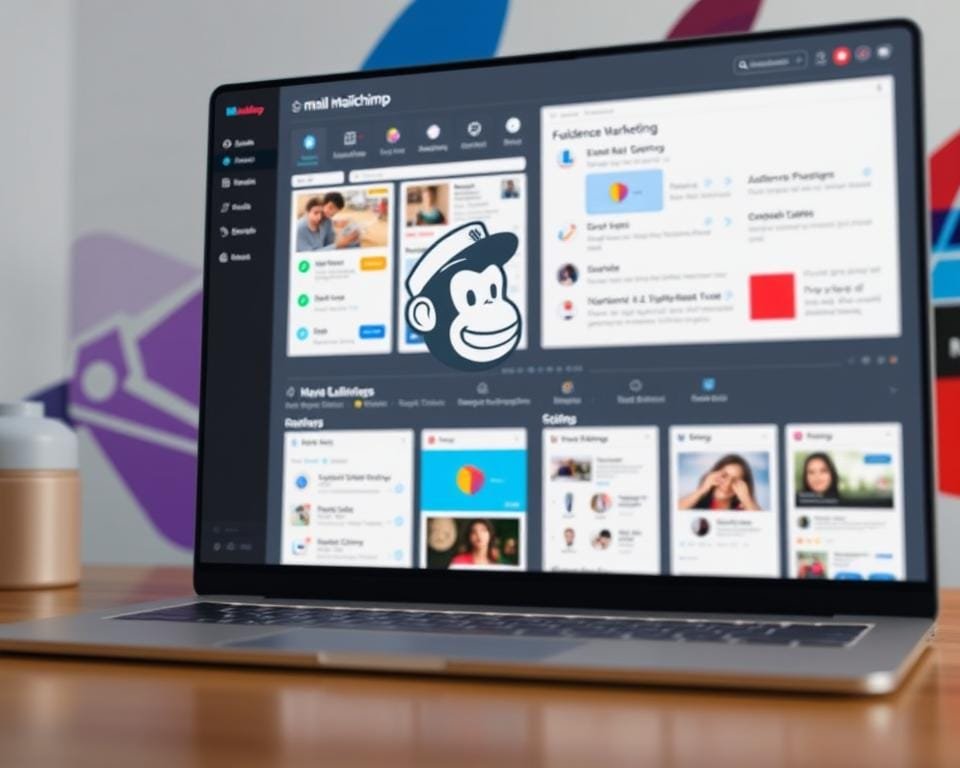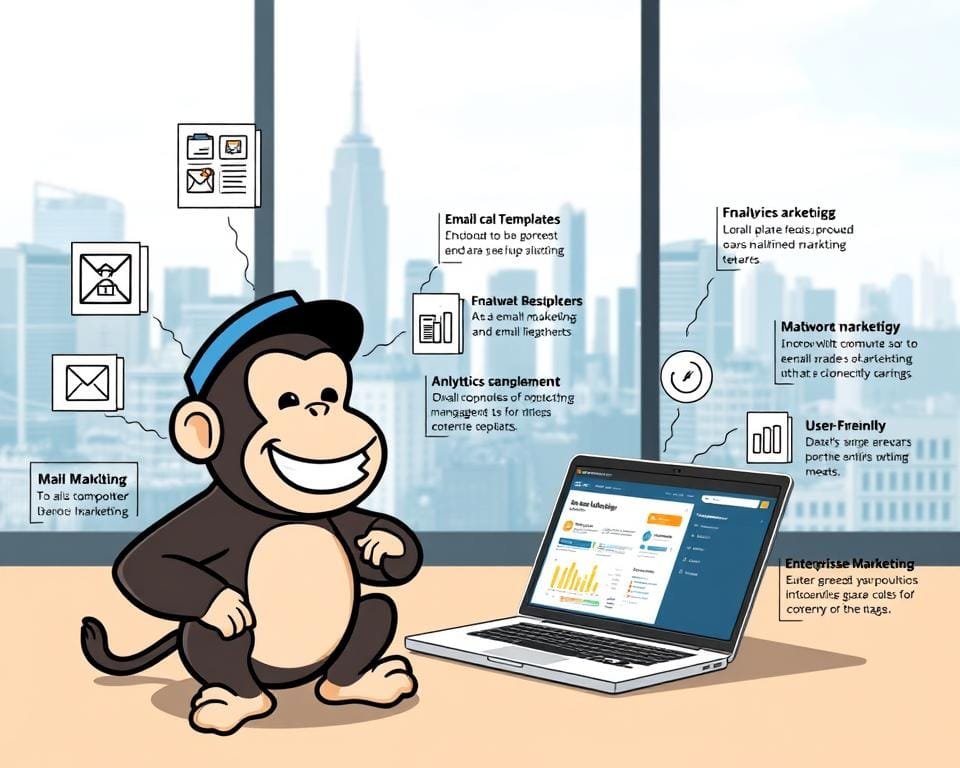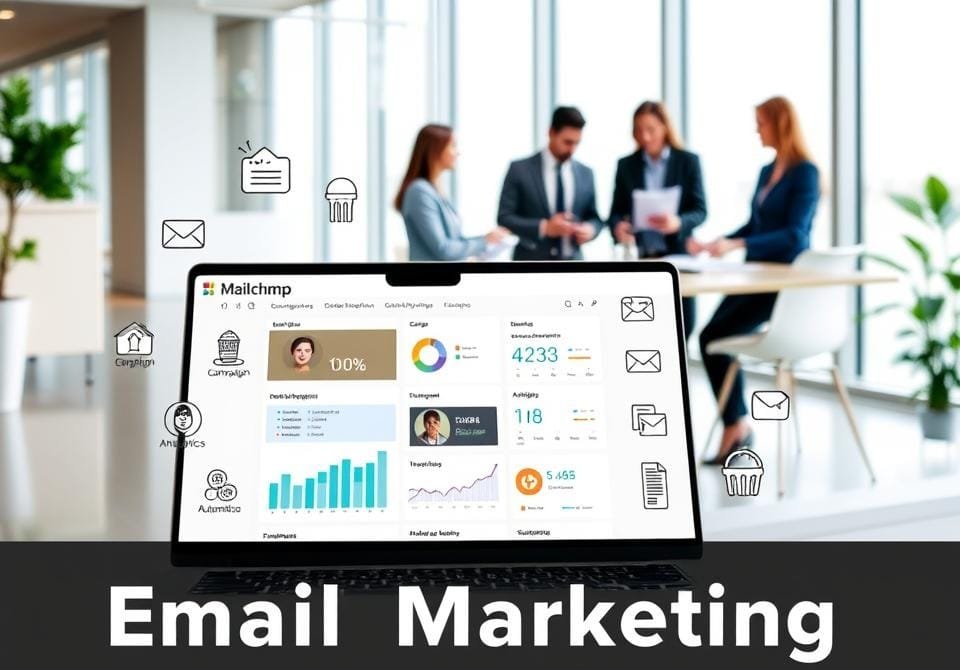Are you struggling to connect with your audience and drive consistent results from your digital marketing efforts?
Email marketing is a powerful tool that can help businesses stay connected with their audience, build trust, and achieve their goals.
According to the Beginner’s Guide to Email Marketing: How to Get Started and Succeed, a well-planned email marketing strategy is essential for businesses to succeed in today’s competitive market.
As a beginner, getting started with Mailchimp can seem daunting, but with the right guidance, you can create effective email campaigns that drive results.
In this guide, we will walk you through the process of using Mailchimp for email marketing, helping you to build a successful email marketing strategy.
What Is Mailchimp?

In the realm of email marketing, Mailchimp stands out as a powerful tool. It is an email marketing platform designed to help businesses and organizations manage and talk to their clients, customers, and other interested parties.
Mailchimp offers a wide range of features that make it an ideal choice for businesses looking to enhance their email marketing efforts. From designing visually appealing emails to tracking the performance of email campaigns, Mailchimp provides a comprehensive suite of tools.
Understanding Mailchimp’s Role in Email Marketing
Mailchimp plays a significant role in email marketing by providing businesses with the ability to design, send, and track email campaigns. Its user-friendly interface and robust features make it accessible to both beginners and experienced marketers.
One of the key features of Mailchimp is its ability to automate email marketing processes. With Mailchimp’s automation tools, businesses can create targeted email campaigns that are triggered by specific actions or events, enhancing the overall efficiency of their email marketing strategies.
Furthermore, Mailchimp’s analytics capabilities allow businesses to track the performance of their email campaigns, providing valuable insights into subscriber engagement and campaign effectiveness.
Why Choose Mailchimp for Email Marketing?

In the realm of email marketing, Mailchimp emerges as a top choice due to its versatility, automation features, and insightful analytics. Businesses looking to elevate their email marketing strategies can significantly benefit from Mailchimp’s comprehensive suite of tools.
Benefits of Using Mailchimp
Mailchimp offers several key benefits that make it an attractive option for businesses. One of the primary advantages is its ease of use, allowing users to navigate and utilize its features without requiring extensive technical knowledge.
Another significant benefit is Mailchimp’s automation capabilities. By automating routine email tasks, businesses can save time and focus on more strategic aspects of their marketing efforts. Mailchimp’s automation features enable users to set up complex email sequences based on subscriber behavior, ensuring timely and relevant communications.
Mailchimp’s email marketing advantages are further enhanced by its robust analytics features. Users can track the performance of their email campaigns in real-time, gaining valuable insights into subscriber engagement and behavior. This data enables businesses to refine their email marketing strategies, improving overall campaign effectiveness.
Additionally, Mailchimp’s ability to integrate with other platforms and tools makes it a versatile solution for businesses. Whether you’re using e-commerce platforms, CRM systems, or other marketing tools, Mailchimp can seamlessly integrate, providing a unified marketing solution.
By leveraging Mailchimp for email marketing, businesses can streamline their marketing efforts, enhance customer engagement, and ultimately drive more conversions. With its user-friendly interface, automation features, and analytics capabilities, Mailchimp stands out as a leading choice for businesses seeking to optimize their email marketing strategies.
Getting Started with Mailchimp

Mailchimp simplifies the process of getting started with email marketing, making it accessible to beginners. With its user-friendly interface and comprehensive features, you can quickly set up your email marketing campaigns and start connecting with your audience.
To begin, you’ll need to set up your Mailchimp account. This involves a few straightforward steps that will have you ready to start creating and sending emails in no time. First, navigate to the Mailchimp website and click on the “Sign Up Free” button. You’ll be prompted to enter some basic information, such as your email address, username, and password.
Setting Up Your Mailchimp Account
Once you’ve completed the initial sign-up process, you’ll need to verify your email address. Mailchimp will send a confirmation email to the address you provided, containing a link you must click to activate your account.
After verifying your email, you’ll be guided through a series of setup steps, including providing some information about your business and selecting the type of audience you’re looking to engage with. This helps Mailchimp tailor its features to your needs.
As you progress through the setup process, you’ll be introduced to Mailchimp’s core features, including how to create email lists, design email campaigns, and track your performance. Mailchimp’s intuitive dashboard makes it easy to navigate these features and understand how to use them effectively.
One of the key benefits of using Mailchimp is its flexibility and scalability. Whether you’re just starting out or you’re looking to grow your existing email list, Mailchimp provides the tools you need to succeed. By following these initial steps and exploring Mailchimp’s capabilities, you’ll be well on your way to creating effective email marketing campaigns that resonate with your audience.
For more detailed guides and tips on maximizing your use of Mailchimp, consider exploring additional resources, such as those available on Bizansy.com, which can provide further insights into email marketing strategies and best practices.
Setting Up Your First Email List

Building a robust email list is the backbone of a successful email marketing strategy with Mailchimp. An email list allows you to connect directly with your audience, share your content, and drive sales. In this section, we will explore how to set up your first email list using Mailchimp’s intuitive tools.
Mailchimp provides a user-friendly interface to create and manage your email lists. To start, log in to your Mailchimp account and navigate to the “Audience” dashboard. Here, you can create a new audience or manage existing ones. Creating a new audience involves entering details such as the audience name, default email address, and contact information. This information helps Mailchimp understand your audience and tailor its features to your needs.
Building and Managing Your Email List
Effective email list building involves more than just adding subscribers; it’s about creating a list of engaged and interested individuals. Mailchimp offers several tools to help you grow your list, including customizable signup forms and landing pages. By integrating these tools into your website or social media channels, you can capture leads and expand your audience.
Segmenting your email list is crucial for running targeted campaigns. Mailchimp allows you to segment your audience based on various criteria, such as demographics, engagement levels, or subscriber preferences. By tailoring your content to specific segments, you can increase engagement and improve the overall effectiveness of your email marketing strategy.
Managing your email list also involves maintaining its health. Mailchimp provides features to help you clean your list by removing inactive subscribers or correcting invalid email addresses. Regular list cleaning ensures that your campaigns reach the intended audience and helps maintain a good sender reputation.
To further enhance your email marketing strategy, consider using Mailchimp’s automation features. By setting up automated workflows, you can welcome new subscribers, nurture leads, or re-engage inactive subscribers. Automation helps streamline your email marketing efforts, saving time and improving campaign performance.
In conclusion, setting up your first email list with Mailchimp is a straightforward process that lays the foundation for successful email marketing. By focusing on building a quality list, segmenting your audience, and maintaining list health, you can create targeted and effective campaigns that resonate with your subscribers.
Designing and Sending Your First Email Campaign

Designing an effective email campaign with Mailchimp involves several key steps, from crafting compelling subject lines to personalizing your content. With Mailchimp’s intuitive platform, you can create visually appealing emails that engage your audience and drive results.
Creating Engaging Email Content
To create engaging email content, start by understanding your audience. Personalization is key; use your subscribers’ names and tailor the content based on their preferences or previous interactions. Mailchimp’s features allow you to segment your audience and create targeted campaigns that resonate with different groups.
Crafting a compelling subject line is also crucial. Your subject line should be concise, informative, and enticing enough to encourage opens. Consider using action-oriented language or posing a question to pique the reader’s interest.
When it comes to email design, simplicity and clarity are paramount. Ensure your emails are optimized for mobile devices, as a significant portion of your audience will likely view your emails on their smartphones. Use a clean layout, clear fonts, and make sure your call-to-action (CTA) buttons are prominent and actionable.
Another best practice is to test your emails before sending them out. Mailchimp allows you to test different subject lines, CTAs, and content variations to see what performs best with your audience. This data-driven approach helps refine your email strategy over time.
By following these best practices and leveraging Mailchimp’s features, you can create effective email campaigns that engage your audience and drive meaningful results for your business.
Automating Your Emails with Mailchimp
Mailchimp’s automation features revolutionize email marketing by allowing businesses to streamline their efforts. By automating repetitive tasks, businesses can focus on creating more engaging content and strategies.
Automation in email marketing is not just about saving time; it’s also about creating a more personalized experience for your audience. With Mailchimp, you can set up automated email campaigns that are triggered by specific actions or timelines, ensuring that your messages reach your audience at the right moment.
Using Automation to Streamline Email Marketing
Mailchimp’s automation tools allow you to create complex email sequences with ease. For instance, you can set up a welcome series that automatically sends a series of emails to new subscribers, introducing them to your brand and offerings.
Key benefits of using Mailchimp’s automation features include:
- Increased efficiency by automating routine tasks
- Enhanced personalization through targeted email campaigns
- Improved customer engagement through timely and relevant communications
For example, an e-commerce business can use Mailchimp’s automation to send abandoned cart reminders, special offers, or product recommendations based on customer behavior, thereby increasing the chances of conversion.
Tracking Performance and Analytics
Analyzing the performance of your email campaigns helps you refine your marketing approach. With Mailchimp’s analytics features, you can gain valuable insights into how your emails are performing.
Email Performance Metrics
To effectively track your email campaigns, you need to understand key performance metrics. Open rates, click-through rates (CTR), and conversion rates are crucial indicators of your campaign’s success.
Open rates indicate the percentage of recipients who opened your email. A higher open rate suggests that your subject line and sender name are effective.
Click-through rates measure the percentage of recipients who clicked on a link within your email. This metric helps you understand how engaging your content is.
Interpreting Your Metrics
Once you have your metrics, it’s essential to interpret them correctly. For instance, a low open rate might suggest that your subject lines need improvement, while a low CTR could indicate that your email content isn’t engaging enough.
By regularly monitoring these metrics and adjusting your strategies accordingly, you can optimize your email marketing efforts for better results.
Mailchimp Pricing & Plans Overview
Understanding Mailchimp’s pricing is crucial for businesses to manage their email marketing costs effectively. Mailchimp offers a range of plans to suit different business needs, from small startups to large enterprises.
Mailchimp’s Pricing Tiers
Mailchimp provides various pricing plans based on the size of the email list and the features required. The plans are designed to accommodate growing businesses, with options to upgrade or downgrade as needed. When considering mailchimp pricing, businesses should assess their email list size and the features they need to achieve their email marketing goals.
By reviewing Mailchimp’s plans, businesses can choose the most suitable option that aligns with their email marketing strategy and budget, ensuring they get the most out of their email marketing efforts without incurring unnecessary costs.
FAQ
Q: What is Mailchimp and how does it help with email marketing?
A: Mailchimp is an email marketing platform that helps businesses create, send, and track email campaigns to their audiences. It provides a range of tools and features to streamline email marketing efforts, including email templates, automation, and analytics.
Q: How do I set up my Mailchimp account and start creating email campaigns?
A: To set up your Mailchimp account, sign up on the Mailchimp website, choose a plan that suits your business needs, and follow the guided setup process. You can then create your first email list, design your email campaign using Mailchimp’s templates, and start sending emails to your subscribers.
Q: What are the benefits of using Mailchimp’s automation features for email marketing?
A: Mailchimp’s automation features allow you to streamline your email marketing efforts by automating repetitive tasks, such as sending welcome emails or abandoned cart reminders. This saves time and helps you deliver timely, relevant content to your audience, improving engagement and conversion rates.
Q: How do I track the performance of my email campaigns using Mailchimp?
A: Mailchimp provides analytics features that allow you to track key metrics, such as open rates, click-through rates, and conversion rates. You can use this data to understand how your email campaigns are performing, identify areas for improvement, and make data-driven decisions to optimize your email marketing efforts.
Q: Can I integrate Mailchimp with other tools and platforms?
A: Yes, Mailchimp offers integrations with a range of third-party tools and platforms, including e-commerce platforms, CRM systems, and social media platforms. This allows you to connect your email marketing efforts with other business systems and workflows, enhancing the overall effectiveness of your marketing strategy.
Q: How do I choose the right Mailchimp plan for my business?
A: To choose the right Mailchimp plan, consider the size of your email list, the frequency of your email campaigns, and the features you need to achieve your email marketing goals. Mailchimp offers a range of plans, from free to paid, with varying levels of features and support.
Q: What are some best practices for building and managing an email list using Mailchimp?
A: Best practices for building and managing an email list using Mailchimp include creating opt-in forms to capture subscribers, segmenting your list to target specific audiences, and regularly cleaning your list to remove inactive or unengaged subscribers.
Q: How can I personalize my email content using Mailchimp?
A: Mailchimp allows you to personalize your email content using merge tags, which insert subscriber-specific information, such as names or locations, into your emails. You can also use Mailchimp’s segmentation features to create targeted campaigns that resonate with specific audience groups.












